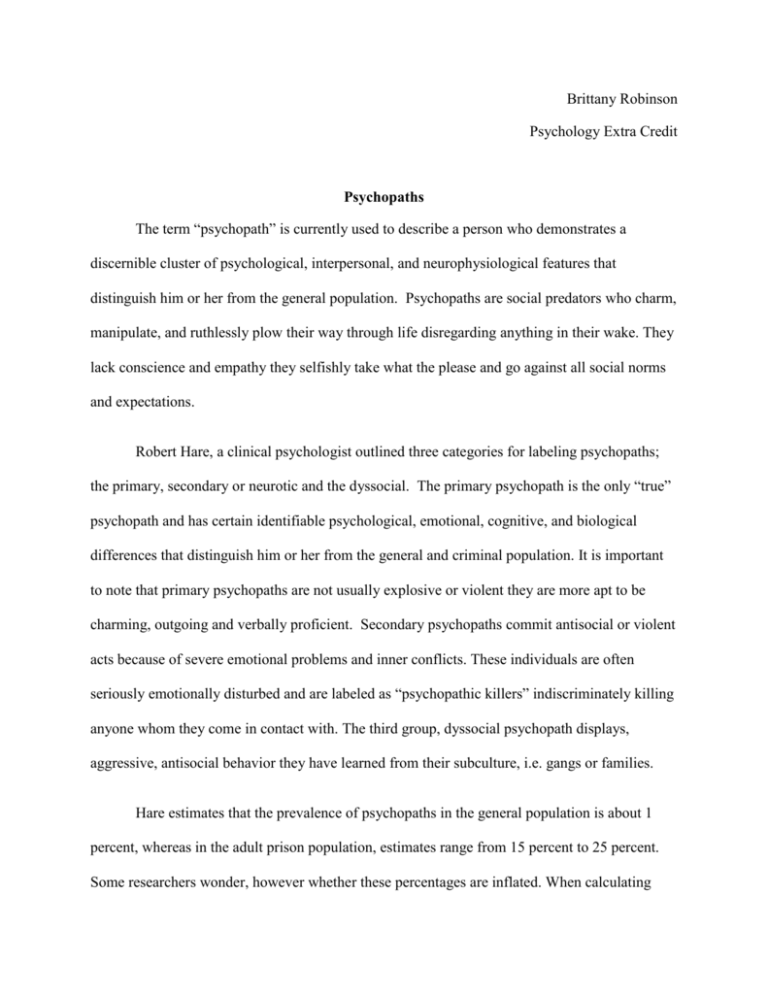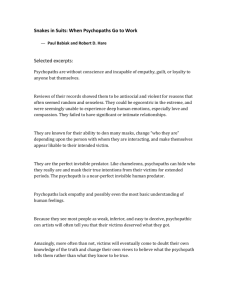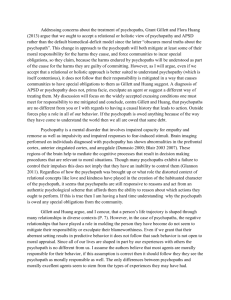File
advertisement

Brittany Robinson Psychology Extra Credit Psychopaths The term “psychopath” is currently used to describe a person who demonstrates a discernible cluster of psychological, interpersonal, and neurophysiological features that distinguish him or her from the general population. Psychopaths are social predators who charm, manipulate, and ruthlessly plow their way through life disregarding anything in their wake. They lack conscience and empathy they selfishly take what the please and go against all social norms and expectations. Robert Hare, a clinical psychologist outlined three categories for labeling psychopaths; the primary, secondary or neurotic and the dyssocial. The primary psychopath is the only “true” psychopath and has certain identifiable psychological, emotional, cognitive, and biological differences that distinguish him or her from the general and criminal population. It is important to note that primary psychopaths are not usually explosive or violent they are more apt to be charming, outgoing and verbally proficient. Secondary psychopaths commit antisocial or violent acts because of severe emotional problems and inner conflicts. These individuals are often seriously emotionally disturbed and are labeled as “psychopathic killers” indiscriminately killing anyone whom they come in contact with. The third group, dyssocial psychopath displays, aggressive, antisocial behavior they have learned from their subculture, i.e. gangs or families. Hare estimates that the prevalence of psychopaths in the general population is about 1 percent, whereas in the adult prison population, estimates range from 15 percent to 25 percent. Some researchers wonder, however whether these percentages are inflated. When calculating these types of percentages it’s important to look at the type of facility, cultural, ethnic, gender, and age mix of the targeted population. Psychopaths are often labeled as having antisocial personality disorder (APD) this term is described as having a total disregard for, and violation of, the rights of others that begins at childhood or early adolescence and continues on through adulthood (American Psychiatric Association, 1994, p. 645) Individuals with Antisocial personality disorder tend to be irritable and aggressive and may repeatedly get into physical fights or commit acts of physical assault. Individuals with this disorder tend to lack empathy and disregard the feelings, rights, and suffering of others. APD cannot be diagnosed before the age of 18 years and is much more common in males than females (Diagnostic and Statistical Manual of Medical Disorders 4th Edition). Antisocial personalities (ASPs) are described as failing to conform to social norms and lawful behavior. They repeatedly perform criminal acts. They are frequently deceitful and manipulative in order to gain personal profit or pleasure. Decisions are made on the spur of the moment without thought and consideration for others. With this being said clinicians often misdiagnose antisocial personality disorder with that of a psychopath due to their behavioral similarities. But there is much more to the diagnosis of a psychopath which includes emotional, neurological, and cognitive aspects. Psychopathy exists on different levels rather than viewing people as either psychopaths or nonpsychopaths. All these factors must be considered when diagnosing a psychopath. Other Traits of a Psychopath Other traits of a psychopath are selfishness and the inability to love or give affection to others. According to Harvey Cleckley, a well-known psychiatrist is Augusta, Georgia, says egocentricity is always present in the psychopath and is un-modifiable. Psychopaths are likeable, but they are unable to keep friends for an extended period of time. They use people for what they need them for and dispose of them when they have accomplished their goals. Psychopaths are distinguished by flat emotional reaction and affect. Since psychopaths have little need to receive or give love they relatively have little to do with their families and many change their locations frequently. When a psychopath drifts into criminal activity, impulsivity prevents them from performing like a professional criminal. Their crimes are often unplanned, but grant them immediate satisfaction.. They lack any sort of remorse or guilt, regardless of the severity of the crime. Violence is not the only distinguishing trait of a psychopath they often engage in such criminal behavior as forgery, theft, rape, and fraud. They take risks for insignificant personal gain. When caught they express no genuine remorse, they may take responsibility for what they did but feel nothing for it. They instead often project blame onto the community and their families for what they have done. An example of a psychopath is Charles Manson whose criminal history spanned over his entire life. His mother was 16 years old when she gave birth to him but she was unable to care for him therefore Manson spent his youth at various relatives’ homes and boys’ homes. Starting at a young age Manson began stealing cars, and participating in forgery, he was in and out of jail most of his teen years. He was unable to nurture a loving relationship with any of his wives and divorced several times. Manson was very passionate about music, after being release from jail in 1967, Manson headed to San Francisco where he hoped to start up a music career he was a song writer and played the steel guitar. When Manson’s music career didn’t work out he was very upset and moved to San Fernando Valley, California. By this time Manson had charmed several followers that would later commit murder for him. Manson would ultimately serve a life sentence for murder and the conspiracy to commit murder. Manson has been evaluated by numerous psychologists over his life sentence. He has no remorse for anything that he has ever done and takes no responsibility for any of his actions. He lives in his own mind and he believes that what he says is true and correct. Criminal Psychopaths Criminal psychopaths are believed to be responsible for an unimaginable amount of crime in society, they are considered to be the most violent and persistent offenders. They are prone to use cold blooded, instrumental intimidation and violence to satisfy their wants and needs. In addition, the unlawful acts of a psychopathic sex offender are likely to be more violent, brutal, unconventional, and sadistic than those of other sex offenders. Psychopathic sex offenders appear to be more motivated by thrill seeking and excitement rather than simply sexual arousal. Psychopaths as a group also appear to be more sadistic than violent nonpsychopaths and commit more diverse and severe forms for sexual homicides. In a sample taken of male offenders incarcerated in two Canadian federal prisons for homicide found that nearly half could be classified as sexual homicide offenders. In order to be classified as a sexual homicide, there had to be physical evidence of sexual activity with the victim before, during, or after the homicide. Murderers described as excessively sadistic and brutal tend to have many psychopathic features (Hare et al., 2000; Stone, 1998). Serial murderers who exhibit psychopathic features tend to be more sadistic and brutal in their murders. With this research, it is thought that psychopaths may be more likely than others to derive pleasure from both the nonsexual and sexual suffering of others. Criminal psychopaths frequently engage in violence as a form of revenge or retribution, or a bout of drinking. Many of the attacks of nonpsychopaths are toward women they know well, whereas many of the attacks of criminal psychopaths are directed toward men who are strangers. The crimes that are committed are callous and cold-blooded. Herbert Quay suggested that much of the psychopaths’ behavior represents an extreme form of stimulation seeking. He hypothesized that psychopaths do not receive the full impact of sensation from the environment and thus are always craving more. This under arousal of the cerebral cortex then requires more stimulation than the average person. Criminal psychopaths are especially difficult to track by law enforcement because their crimes appear to lack rational motives. Even worse they show no remorse or ability to be rehabilitated. Recidivism is also very high among psychopaths they have the tendency to return to criminal offending even after being caught regardless of the methods used to stop or rehabilitate them. Research suggests that psychopaths reoffend faster, violate parole sooner and commit more violent crimes. It seems that they have no interest in stopping their behavior or seeking treatment. Biological Factors of a Psychopath There is a belief among the general public that psychopathic tendencies are caused exclusively by social factors, such as abuse and poor upbringing. But researchers have implicated a variety of biological factors as well. Research favors the view that psychopathic behavior results from a complex interaction between neuropsychological and learning or socialization factors. There is little evidence that suggests genetics plays a role in the development of a psychopath. Some evidence suggests that temperament linked to low arousal and fear responses is associated with psychopathy. This sort of temperament can disrupt the formation of guilt, conscience, or concern about punishment. Increased attention to development and genetic research especially those interested in twin studies believe that genetic contributions may play a significant role in the emotional dysfunction found in psychopaths. And heredity may contribute to the under arousal and low emotional responsiveness of psychopaths. However the scientific experimentation is still in the early development stages. Research into the investigation of neuropsychological factors involved in determining a psychopaths behavior begins with neuropsychological indicators called markers. The human nervous system can be divided into two major parts; structure and function. The central (CNS) and peripheral (PNS) nervous system are the two main parts. The CNS is associated with the brain and spinal cord and the PNS is associated with the nerve cells called neurons. The function of the PNS is to bring outside information into the CNS where it is then processed. Once information is processed it relays the interpretation back to the PNS if further action is necessary. Since the CNS consists of the brain and spinal cord it is vital in interpreting memories, and thoughts. It is the processing center for stimulation and sensations received from the outside world through the PNS. The cerebral cortex contains more than 100 billion neurons that is the link for all communication between the neurons creating a complex communication network. The physical structure of the brain has nothing to do with the diagnosis, but more so the electrical circuitry which is relevant in understanding the neuropsychological make up of a psychopath. Neuropsychological Studies It is said that psychopaths may also suffer from frontal lobe problems and or dysfunctions. The frontal lobe is responsible for decision making, emotional processing, cognitive flexibility, regulation of impulses, and the control of one’s behavior. If the frontal lobe is damaged in anyway the damage could result in poor decision making, and reduced autonomic functions. This study was performed over a 30 year period, measuring functioning psychopaths that have yet to be incarcerated and psychopaths that have been in the prison system. Some psychologists disagree with this study and its research. But there is no doubt that there are some kind of function deficiencies, which result in lower impulse control, judgment, and planning. Growing Up a Serial Killer Ted Bundy is one of America’s most notorious serial killers he terrorized women in the 1970’s. Before his death by electric chair in 1978 he confessed to killing over 30 women. But law enforcement believes that number is much higher. Bundy was said to be charismatic, charming, and trustworthy. He was confident in what he did and would often approach women in public places where he would pose as an authority figure, or claimed to have an injury or disability. Gaining momentary trust of his victims he would then overpower them in more secluded locations. Bundy attended law school and had become active in politics in California. His profile as a serial killer was incomprehensible to many who knew him throughout his life. But some could see through to who he really was. His fiancé once said “cross him and you could see the cold fury pass across his eyes.” A living witness from Lake Sammamish told investigators, Bundy had the spooky eyes of a predator focused on its prey. Very near the end of his life, when those very same predators eyes saw everyone around him had failed and he was left all alone staring at the prospect of death by electric chair, I myself saw that all his personalities seemed to have melted away, leaving a panicked, angry, empty creature gripped in the reality of its own impending death. Like a monster in a horror movie who transforms back to its real self at the point of destruction. Ted Bundy was considered an “adaptive psychopath,” they seem normal and functional on a day to day basis, but they are especially elusive. Most adopt the idea that they will never get caught this enables them to have dissociative capacity and antisocial behavior during their “normal” periods. But how exactly does a psychopath become a psychopath? Does it have to do with childhood, genetics, traumatic injury, behavior, or bio-psychological components? The answer may not be that simple. Criminal behavior and other behavior problems are often said to be rooted at home, usually in homes with conflict, inadequate discipline, or poor parental models. Psychopaths seem to be the result of highly complex interaction of bio-psychological, social, and learning factors. Ted Bundy’s childhood was less than perfect he never knew who is father was and his family lied to him consistently throughout his childhood even going as far as telling them his mother was in fact his sister while being raised by his grandparents who he thought were his real parents. Childhood trauma is no excuse to become a serial killer nor is it a direct result of a person becoming a psychopath. There is little evidence to support that psychopathy is in fact genetic. But it has been said that a psychopath is born with a biological predisposition to develop the disorder and that this predisposition requires certain psychosocial factors before emerging, such as neglectful or abusive parents. Psychopaths have a nervous system that interferes with rapid conditioning and the anticipation of punishment; therefore psychopaths fail to anticipate punishment and therefore feel no guilt and have no conscience. Social factors also play a major role in affecting predispositions. If the child is neglected by their parents and then goes onto also be rejected by peer groups in early childhood this affects adulthood and they often become withdrawn from society. However, just because a child grows up with these types of dispositions does not mean that they are destined to be a psychopath. There is no known treatment for psychopathy in the criminal justice system. There have been many attempts to formulate a treatment plan with little success. Several studies indicate that psychopaths are either completely nonresponsive to treatment or play the treatment game well, pretending to cooperate but in actuality are conning the treatment provider. The reason treatment is so unsuccessful is a psychopath is constantly looking for ways to distract the interviewer, rationalize his behavior, or deflecting blame. A psychopath is so ego driven they can do nothing else but try and control a situation they cannot produce genuine reasons or genuine feelings. Doctors Eve Bernstein and Frank Putnam devises a scale called the Dissociative Experiences Scale (DES). This scale was devised to provide the serial murder researcher with an instrument that might lead to the collection of valuable date from serial murderers who are presently incarcerated. The Dissociative Experiences Scale was developed to offer a means of reality-measuring dissociation in normal and clinical populations. Scale items were developed using clinical data and interviews, which involved memory loss and consultations with expert on dissociation. The scale resulted in a 28 question self- report questionnaire. Some of the questions include; Some people have the experience of finding themselves in a place and have no idea how they got there. Some people sometimes have the experience of feeling as though they are standing next to themselves or watching themselves do something and they actually see themselves as if they were looking at another person. Some people find that in one situation they may act do differently compared to another situation that they feel almost as if they were two different people. In their original study, the authors asked the subjects how often they felt this way and asked them to rate it on a scale of 0 to 100 percent of the time. In addition the age, sex, occupation and education level was also collected so the variables could be examined as well. The test was administered to between 10 and 30 subjects ranging from normal adults, late adolescent college students and people suffering from alcoholism, agoraphobia, schizophrenia and PTSD, and other mental disorders. Bernstein and Putnam reported that the DES is internally consistent and yields scores that are stable over time. The test is able to differentiate between subjects with and without clinical diagnoses of dissociative disorder With all of the research done on psychopaths there is still so many unanswered questions as to why they behave the way that they do and where the behavior stems from. These people are out in society everyday fooling people for their own personal gain. Studying them in clinical settings is nearly impossible because their constant need to evade any truth and give any insight into their mind or why they do the things they do. Psychopath’s overt behavior suggests that only in situations of threat and danger do they feel truly alive. They lead a double life pretending to be someone else. But when they are truly alone with themselves their true darkness comes out. They are not social, only superficially gregarious; not considerate, merely polite; not self-respecting, just vain; not loyal, and deep down they are quite shallow. It is no wonder that these people can function in normal society for they are chameleons among us able to pretend and conceal who they really are. Once they are caught is the only time that psychopaths can truly be stopped. References Curt R. Bartol, Anne M. Bartol. 2011, Criminal Behavior a Psychological Approach, Ninth Edition. Diagnostic and Statistical Manual of Mental Disorders, DSM-IV-TR Fourth EditionRobert D. Keppel, Ph.D., with William J. Birnes 1997. Signature Killers Interpreting the Calling Cards of Serial Murderers. Steven A. Egger, 1990, Serial Murder An Elusive Phenomenon. Karl Jaspers, 1959 General Psychopathology, Volume II






